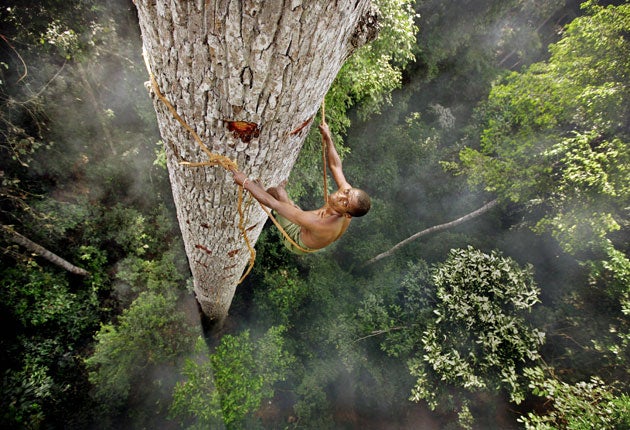Story of survival: How the BBC has revived photojournalism
The 'Human Planet' photographer tells Matthew Bell why he wanted a more elevated focus

Gazing up at the camera, the Bayaka tribesman collects honey from the bark of a tree, 130 feet above the forest canopy.
Only a fraying strip of creeper keeps him from death. It's a dizzying image, showing the ingenuity and bravery of a human at work, and is one of dozens of beautiful pictures captured in the making of the BBC's landmark eight-part television series Human Planet, which begins on Thursday.
But behind the camera lies a story of ingenuity and bravery no less astonishing. Rigged in a harness and pushing himself away from the trunk to get the right shot was Timothy Allen, 39, who spent nearly two years travelling the world to photograph this epic project. Running for eight weeks, the series is the first time the BBC's Natural History Unit has focussed on the ultimate animal – us.
The decision to appoint a photographer to shadow the camera crews was unusual and slightly old-fashioned. In big-scale nature documentaries, it's uneconomical to have both a photographer and a cameraman waiting side-by-side for hours for a shot of, say, a lava pupating. But, as Allen explains, humans operate on knowable and manageable timetables, making a parallel photographic series possible.
The result is an exquisite hardback book, which has already sold out in pre-sales; a second print run has been ordered. For Allen, it has been the biggest job of his career. "Projects like this don't really happen any more in photography," he says. "They used to in the 1970s, in the heyday of photojournalism, when the National Geographic would send you off for two months to find your story."
The tale of how Allen came to land the job begins here at the IoS, where he was a photographer for six years, after which he quit to go travelling. "I wanted to flex my photographic muscle. I was living in London and I knew I wanted a big change. I was single. I sold my house, quit my job and set off, just me and my camera."
Without knowing where to go, Allen turned to Google, and tapped in "the remotest country in the world". Up came Bhutan, and off he went. His travels in that small kingdom at the eastern end of the Himalayas took him to the equally untravelled frontier states of north-east India. It was while a BBC researcher was looking into this underexposed area – ethnically different from the rest of India – that Allen emerged as an ideal addition to the team. It was he who came across the Khasi people of Meghalaya, who create extraordinay bridges out of living trees.
Working on the series meant travelling to 40 countries, usually for two or three weeks at a time. Four teams, each covering two regions, worked on the eight episodes, often living with the people they were filming. Human Planet visited some of the earth's remotest people. How did they react to the media?
"The more remote the people are, the more welcoming," he says. "But there does come a point when the media corrupts . There are three stages: when people have no idea what the media is, then you get an incredible time. You're given access to everything, you're treated like an important person. In the second stage, they have been corrupted by the media, and they try to get everything they can from you. The third stage is when they don't care any more, and realise the media is not that bad. We're not out to stiff them. But I've never had an experience of not being welcomed."
Intriguingly, he considers his current work to be neither art nor journalism. "Photography is not a great art. What I like about it is that I get to show people something I saw that I liked. This is travel photography."
The downside to travelling so much is the weeks he spends apart from his girlfriend, though he says "she understands the fire that burns in a man's soul when he wants to go and do something." Is photojournalism kinder to men? "Men are luckier in a lot of ways, but actually, I would say women get a lot more opportunities because the female perspective has rarely been told."
After Human Planet, Allen can't complain about opportunities. But more than the photographs, it's the memories he prizes, like hanging 130 feet up a tree to capture the Bayaka honey-gatherer. He underwent extensive training in abseiling for that shot, including a week climbing trees at Westonbirt Arboretum, though he was still terrified. "I'm scared of heights, and I was up there for an hour. The worst thing is that you have to change the position of the harness to come down. It would have been easy to undo the wrong clip. It was incredibly nerve-racking, but it's memories like that that I love."
Join our commenting forum
Join thought-provoking conversations, follow other Independent readers and see their replies
Comments